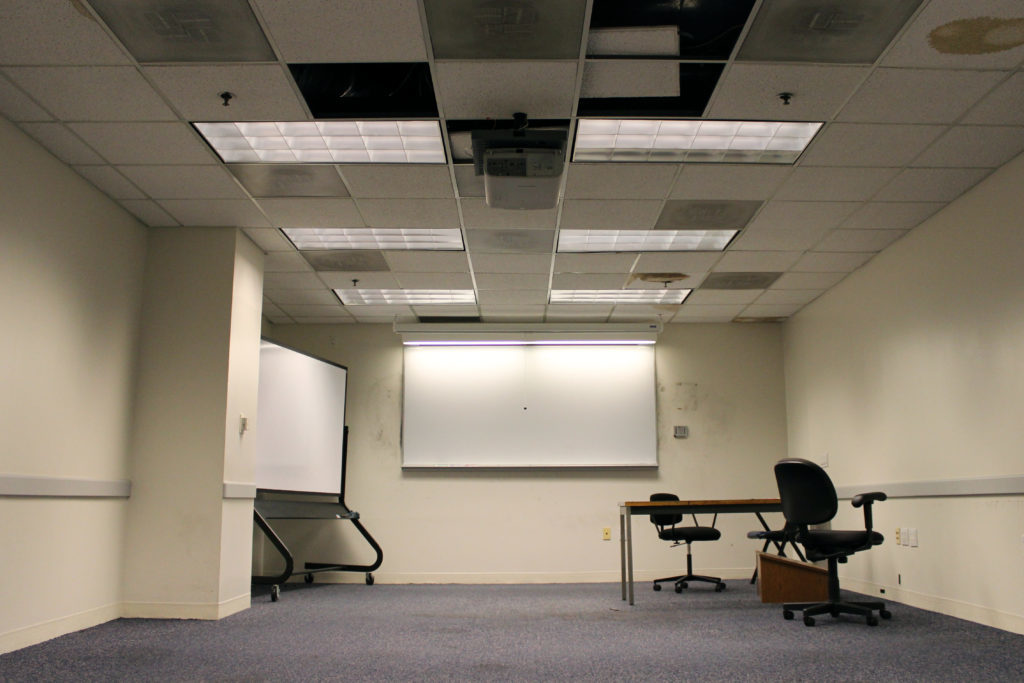The University is moving out of 2020 K St. this summer, and faculty say they’re relieved to no longer teach classes in the building.
Officials said they will end their lease on 2020 K St. as a part of a University-wide goal to cut down on rented space. Faculty welcomed the decision to vacate the building, saying its windowless classrooms, unreliable technology and cramped hallways made it an object of derision among students and faculty.
Provost Forrest Maltzman said in January 2015 that the space would not host classes after the spring 2015 semester as the University planned to phase out its use of the building. But the building has held classes every semester since January 2015 up through the fall 2016 semester, according to the schedule of classes.
University spokesman Brett Zongker said the University will leave the building this summer and instead use more space in 1776 G St., another building where GW leases space.
Kim Roddis, a professor of civil and environmental engineering and the chair of the Faculty Senate’s physical facilities committee, said 2020 K St. was a problem when she came to GW in 2004 because of the poor physical conditions of the building. As the chair of the physical facilities committee, she said she worked with administrators to reduce the number of classes in the building.
“I think it’s great,” she said. “It makes me feel like I’ve got something done that benefits my students.”
“In my department it appeared to be clear that space was rated as lowly by students as it was by faculty.”
Since the University began leasing space in 2020 K St., students and faculty have expressed concerns about the quality of the building, Roddis said. As former chair of the civil and environmental engineering department, she said she heard complaints from faculty that they didn’t want to teach classes there because the rooms were in poor condition.
“They’re narrow, they have very little board space, they have obstructed views with columns in the way, it’s in the basement, they’re difficult to get to, they’re dark, they have relatively low ceilings,” Roddis said.
She said students also disliked taking classes in the building because of its cramped conditions and distant location from much of campus.
“In my department it appeared to be clear that space was rated as lowly by students as it was by faculty,” she said. “It was their last choice for where they wanted to be taught.”
The move is part of a larger University strategy to cut down two-thirds of the University’s leased spaces by this year. Launched in 2011, the project was designed to save GW $3 million each year until 2017.
Roddis said that with the creation of the Science and Engineering Hall, the University hoped to move classes previously held in leased spaces into that building.
Roddis said that while 2020 K St. was used longer than planned, officials worked to reduce the number of classes held in the building from a high of 20 each semester to about four this academic year. To end the lease early, Roddis said GW would have had to spend extra money in a buyout.
Faculty members who taught classes in 2020 K St. said they were relieved that GW would no longer use the space.
“No, they didn’t get it done as quickly as the faculty and students wanted,” Roddis said. “But, from my point of view, they got it done as quickly as the real constraints on the ground allowed them to do.”
Faculty members who taught classes in 2020 K St. said they were relieved that GW would no longer use the space.
Geoffrey Carter, an associate professor of English who taught Shakespeare I in the building last semester, said there were no windows in the classrooms, creating a disruptive and unsafe environment. Every class in 2020 K St. was held in the building’s basement.
“All faculty have always hated this building for very obvious reasons,” he said. “It’s got tight access and is an obvious fire hazard. It has no windows and the air circulation makes a distracting noise.”
Yvonne Captain-Hidalgo, an associate professor of Latin American film and literature, taught a Latin American literature class in 2020 K St. during the fall 2016 semester. She said unreliable technology and temperature control in the space detracted from the quality of learning.
“Several times, I had to call the tech office, losing precious time for classwork, because heating and cooling in the building was not optimal,” she said. “I won’t miss a thing.”
Susan Johnston, a professional lecturer of anthropology, said the rooms weren’t equipped with computers and the electrical outlets were too far away from the projector plug-in making it difficult to use technology.
“One semester, I had to balance the laptop on a chair in order for it to reach the two separate walls,” Johnston said. “It was a disaster.”





